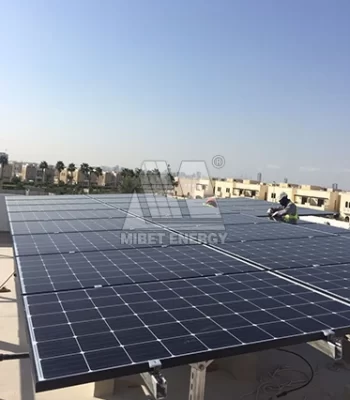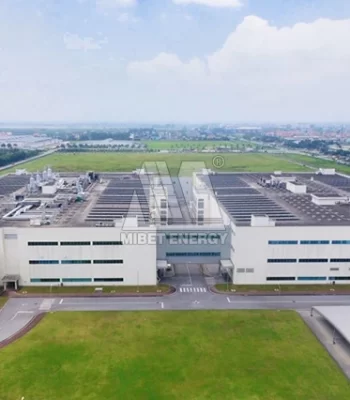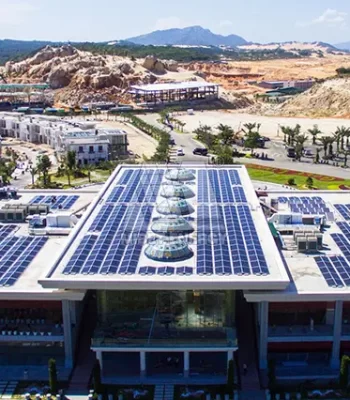- HOME
- ABOUT US
- SOLUTIONS
- Metal Roof PV Mounts and Systems
- Flat Roof Solar Panel Mounting Systems Solutions
- Tile Roof Solar Mounting Systems Solutions
- Solar Tracking Solutions for Commercial PV Projects
- Ground Solar Mounting Systems Solutions
- Floating Solar Solutions - PV Systems
- PV Solar Carport Mounting Systems Solutions
- Balcony Solar Panel Mounting Systems Solutions
- PRODUCTS
- PROJECTS
- COMPANY NEWS
- BLOG
- Contact Us
Flat Roof Solar Panel Mounting Systems Solutions (Ballast & Triangle Frame)
Mibet flat roof solar racking system provides strong and sturdy support for solar modules. Depending on your needs, it can be adjusted to multiple angles from 10~18 degrees, 18~30 degrees, and 30~60 degrees. This cost-effective system requires no roof penetration and is made of lightweight and strong aluminum construction. It comes with pre-assembled components and requires only a few tools to install.
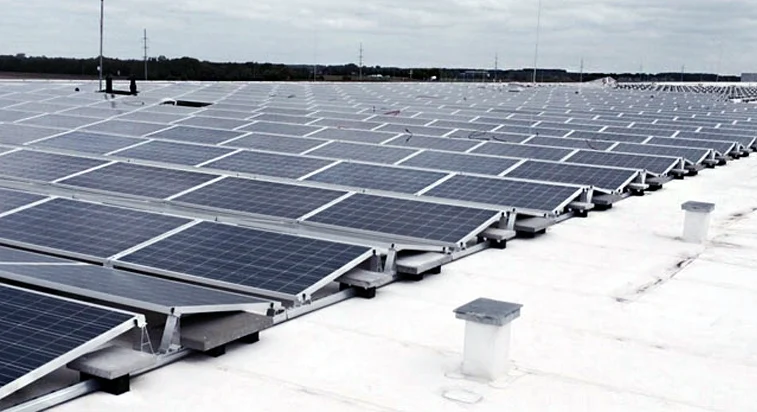
Solar panel installation on residential or non-residential buildings is a logical development. After all, there is plenty of available space on the roof and if large enough, additional profitable functions can be realized. Mibet is one of the pioneers in the field of flat roof mounting systems, offering different solutions depending on the project. Mibet’s solar mounting systems for flat roofs have been designed with careful consideration for roof and wind load, ensuring that they meet the highest safety standards. Our flat roof product range stands out due to its simplicity and ease of installation.
Advantages of Flat Roofs for Installing Solar Panels
Here are some of the benefits of installing solar panels on flat roofs and why they can be a successful solution.
1. Flexibility in Installation Methods
When installing solar panels on a sloping roof, you must work with the roof’s existing angle and pitch. This is not the case when installing flat roof panels. Because there is no pitch, the system can be angled to capture the most sun and work as efficiently as possible. A good solar panel angle ranges between 30 and 60 degrees.
Panels can be installed in the center of the flat roof or on either side with no obstacles in their path. Installers secure the flat roof solar panels with specially designed brackets and then angle them precisely as needed. If there is any concern about their ability to withstand inclement weather, metal frames or ballast can be added for added support and weight.
2. Self-cleaning and Safer Upkeep
Many people are concerned about how they will keep solar roof panels clean and free of damage and general wear and tear. Rain falls heavily in many areas, allowing the panels to self-clean as water runs down them. This is still possible with flat roof solar panels because they can be slightly angled to allow the rain to do its job. Flat roof maintenance and repairs are often simplified because there is usually enough space around the panels for someone to stand safely for as long as they need when checking and working on the panels.
3. Increased Wind Resistance
We’ve already discussed how rain can help keep flat roof solar panels clean if they’re angled up enough to let the water run down them. Wind, on the other hand, can be far less beneficial to solar panel systems, especially if they are installed on sloping rooftops that are too tall to withstand high winds without damage. Choosing your own flat roof angle allows you to adjust the slant to account for high winds, making the system safer and less vulnerable to storm damage.
4. Simple Access to Renewable Energy
Flat roof solar panels are just as effective as sloped roof solar panels at generating renewable, sustainable electricity from the sun’s rays. They are made of the same photovoltaic cells that capture solar energy before converting it into usable electricity for the home or workplace. An additional battery for solar power storage can also be connected to the system, allowing any excess electricity not used immediately to be stored and used later. For example, when the sun’s rays are absent at night, or when they are weaker or obscured on a cloudy or dull day.
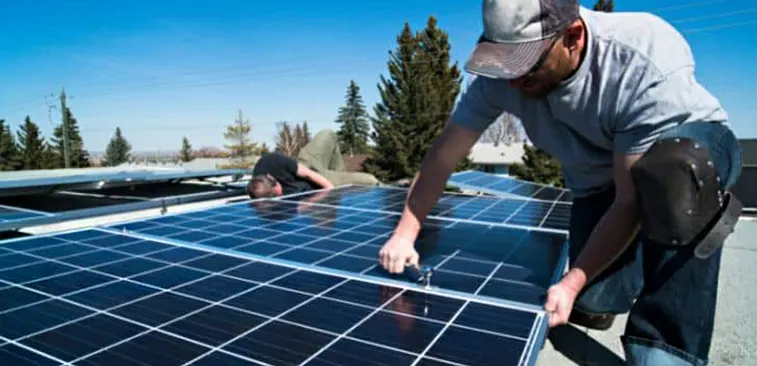
Installing Solar Panels on Flat Roofs
Flat Roof Solar Mounting System
The MRac flat roof solar mounting system can be perfectly adapted to the respective module dimensions and generally does not require any roof cladding penetration during installation. To ensure complete corrosion resistance, every component in the system is made of aluminum and stainless steel.
Flat roof PV mounting systems are frequently available in two configurations. The modules are either aligned and “elevated” only in the south direction, or in the east and west directions alternately. Solar panels can be installed at the optimal angle to maximize energy production.
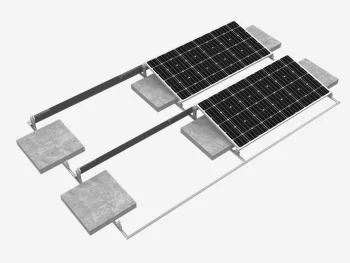
Ballasted Flat Roof System With No Roof Penetration Needed
Ballasted Flat Roof Mounting System RMIPro does not require any roof penetration to mount solar panels. It is a PV mounting product that can be installed at...
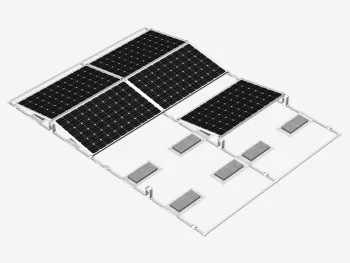
Flat Roof Solar Panel Ballast-optimized Mounting System (East-West)
Solar panel ballast mounting systems are simple and effective solutions for non-penetrating flat roof installations and can also be used for ground...
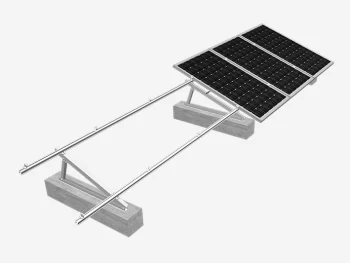
Flat Roof Flexible Adjustable Triangular Solar Mounting System
The Flat Roof Adjustable Triangle Solar Mounting System is designed for quick and easy installation, with adjustable tilt angles to suit project installation...
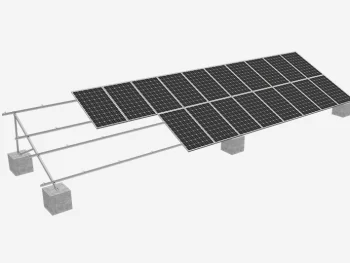
Flat Roof Solar Double-row Tripod (No Bottom Beam) RMIV System
The double-row tripod without bottom beam RMIV is optimized based on the RMII to meet the requirements of different roofing situations for solar mounting...
Triangle frame and ballast mounting are suitable for flat roofs. Both solutions can assist in increasing solar power. Flat roof solar panel systems are more flexible than sloped rooftop installations, making it easier to get the most out of your panels. We extensively tested the PV mounting system in the wind tunnel and optimized it for use in windy regions to ensure minimal additional roof load.
Features of Mibet Flat Roof Solar Mounting System
● Safe, lightweight and cost-effective for commercial solar projects on flat roofs.
● Mounting solutions tailored to your solar project.
● We offer pre-assembled mounting system components to make installation easier.
● Our sturdy racking systems distribute the array’s weight evenly and overcome roof load limits or wind load challenges.
● The use of aluminum and stainless steel ensures the system’s long-term durability and low maintenance costs.
● Report on Strength Analysis, mountings will be tested to meet your target strength, such as wind speed and snow load.
● Non-Penetrating to concrete roof.
● Angle options include 10-15 degrees, 15-30 degrees, 30-60 degrees, and customized.
● Low ballast, supported by the national standards and wind-tunnel tests.
● All components evaluated for superior structural performance.
Flat Roof Solar Reference Project
Why You Can Trust Mibet’s Flat Roof Mounting Systems?
Mibet flat roof solar mounts are specifically designed for quick and easy installation regardless of construction or structural condition. Our highly skilled structural engineers meticulously calculate the best design for your roof’s specific shape, size, and slope. This ensures that the loads are distributed optimally across the structure of the building while remaining within the load limit.
In addition to the local wind rates and snow loads, our team considers all relevant building regulations. We are committed to minimizing the amount of work done to your roof throughout the installation process. We achieve this through careful planning and intelligent design. This ensures that your roof is completely leak-proof and in good condition.
Why Choose Mibet’s Solar Mounting System?
With over ten years of experience as a leading global provider of photovoltaic system solutions, we continue to be an industry leader in the structural design and loading of photovoltaic mounts. Our products have been certified by AS/NZS1170, TUV, MCS, UL and SGS.
In addition, Mibet offers a one-stop solution for your flat roof solar project needs. Our engineers will design a targeted project solution based on your requirements for structure, appearance, cost, etc. We will use 3D modeling technology to ensure that the solution is executable.
Thanks for following us, ready to discuss your solar project?
We provide our customers with perfect-fitting, highly customized solutions.
- [email protected]
- +86-592-3754999
ABOUT MIBET
© 2024 Mibet Energy All rights reserved.
Privacy Policy – Legal Notice – Terms & Conditions

